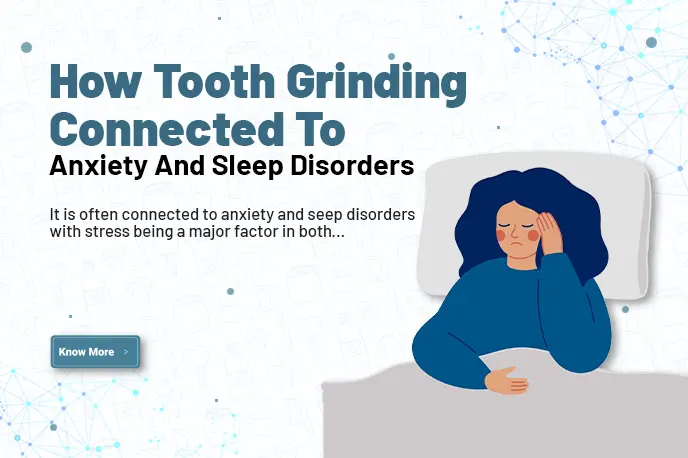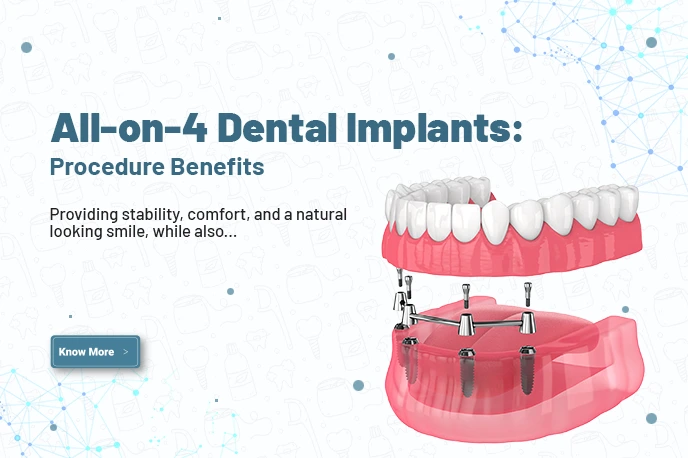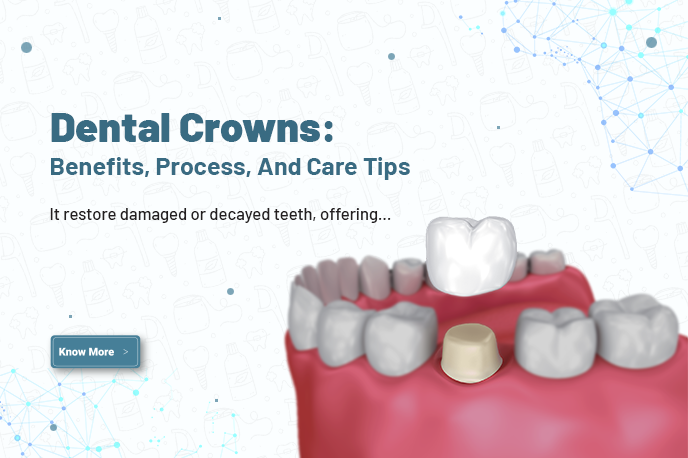The medical term for tooth grinding or jaw clenching is Bruxism. It is a dental condition in which a person rubs their teeth unconsciously, also called clenching or grinding. It is a common problem, especially in children, and it can happen during the daytime or at night.
A study says that tooth grinding and jaw clenching during sleep affect around 8% to 10% of adults and 15%—40% of children, with a higher prevalence in children that decreases over time with age.
Types Of Tooth Grinding (Bruxism)
Sleep Bruxism
Grinding or clenching your teeth while in sleep can cause more serious harm to your teeth than Bruxism in the daytime or walking hours because you do not realize that it’s happening.
People with sleep bruxism often need dental treatments to help manage the effects of grinding because in sleep you do it unconsciously and can’t control your teeths from grinding or clenching.
Awake Bruxism
Tooth grinding can also occur during the day when a person is under extreme stress, which is called waking Bruxism or diurnal Bruxism. Those affected with anxiety unconsciously clench their teeth.
Feeling angry, stressed, or anxious can make you clench your teeth. You might also notice your jaw clenching hard when you are focusing or concentrating on something. You can control the grinding and clenching of your teeth when you are awake to prevent any tooth damage and jaw pain.
What Causes Tooth Grinding?
There are several causes of Tooth Grinding that are as follows –
-
Stress and anxiety
Feeling fearful, stressed, or overwhelmed can lead to Bruxism, but if you are suffering from anxiety or depression or have a major depressive disorder (MDD) or generalized anxiety disorder (GAD), then you are more prone to having Bruxism.
-
Sleep disorders
Studies have shown that sleep apnea is a contributing factor to sleep bruxism, and those who are suffering from sleep apnea mostly experience grinding and clenching of teeth during sleep.
While the exact cause of tooth grinding is still not fully understood, it is said that the body’s attempt to open an airway during sleep apnea often leads to teeth clenching and jaw grinding during sleep.
-
Lifestyle factors
Certain lifestyle habits related to stress, and those who smoke, drink alcohol, and consume enough caffeine on a daily basis (more than six cups a day) are likely to have Bruxism during sleep.
Signs You Might Be Grinding Your Teeth
Tooth clenching and grinding are common involuntary reactions to anger, stress, or fear. Tooth grinding usually happens at night when you are asleep. People who grind their teeth at night do not notice their jaw activity, but the person sleeping next to them does.
The person affected by tooth grinding does not have any clue that they are affected by tooth grinding, but the person sleeping next to them woken up by the tooth grinding noises knows that they are grinding their teeth while sleeping.
-
Jaw Pain Or Soreness
If you experience persistent discomfort, stiffness, or soreness in the jaw, especially in the morning, then it may be a sign of Bruxism.
-
Worn-down, Chipped, Or Sensitive Teeth
Your teeth may become sensitive to hot and cold drinks, and you can experience the wearing down of your teeth, leading to flattened or chipped surfaces that can even lead to tooth loss.
-
Headaches In The Morning
Tooth grinding during the night can lead to tension in the jaw, neck, and head muscles, leading to headaches in the morning that can trigger migraine accompanied by nausea.
The Connection Between Tooth Grinding, Anxiety & Sleep
Stress, anxiety, and sleep disorders are one of the main causes of tooth grinding, which is called sleep Bruxism in medical terms.
-
How Stress And Anxiety Lead To Unconscious Clenching
Stress and anxiety can lead to unconscious jaw clenching because, in stress, a person’s body releases certain hormones like cortisol and adrenaline that cause muscle tension, including the jaw, as a psychological response.
-
Sleep Bruxism As A Response To Disturbed Or Poor-Quality Sleep
Sleep bruxism is also a result of disturbed or poor-quality sleep caused by a busy lifestyle or due to having a sleep disorder such as (insomnia or sleep apnea) that causes difficulty in sleeping.
-
Vicious Cycle: Anxiety → Grinding → Pain → Sleep Loss
Stress is a major trigger for bruxism, as the body’s response can lead to muscle activity. The act of grinding at night can disrupt sleep, leading to fatigue and stress.
Bruxism can be considered a vicious cycle, as stress and anxiety can trigger bruxism, which in turn can worsen stress, affecting sleep, leading to a cycle of discomfort and sleep Bruxism.
-
Research-Backed Connection Between Mental Health And Oral Habits
Oral and mental health are linked with each other. People with severe mental health conditions are more prone to having poor oral hygiene and tooth loss due to impaired well-being and side effects of Psychiatric treatment.
Oral problems can also be caused by changes in lifestyle due to mental health disorders such as inadequate diet, more carbohydrate consumption, and substance use.
Why It Matters: Risks of Untreated Bruxism
Untreated Bruxism can lead to various health problems that are listed below –
-
Damage To Teeth (Cracks, Flattening, Enamel Loss)
Persistent tooth grinding can chip, crack or even fracture your tooth and it also wears down the protective covering of your tooth enamel making it more susceptible to decay, and infection leading to tooth loss.
-
TMJ Disorders (Jaw Joint Issues)
Teeth grinding causes excessive stress on the temporomandibular joints that is the connecting point of the jaw to the skull leading to TMJ disorder characterised by jaw pain, clicking or popping sounds, headache, and difficulty in opening the mouth fully.
-
Sleep Disturbance And Fatigue
Severe headaches, migraine, and pain in the jaws can lead to disturbed sleep, causing nausea and fatigue that can worsen your oral and mental health conditions.
How We Can Help at Dacula Dental Associates LLC
At Dacula Dental, we use cutting-edge dental technology to help create trust and confidence for the best service before and after the treatment.
-
Custom Night Guards To Protect Teeth
These guards are of higher quality that are custom made for your teeth by taking the impressions of your teeth. This appliance protects your teeth from grinding and clenching. You can wear these guards during sleep to reduce the effects of TMJ disorders.
-
Bite Analysis And Adjustments If Needed
Your dentist or a dental professional will take the impressions of your teeth in a mold to make a guard that perfectly fits your teeth. After that, your dentist will perform a bite analysis and make an adjustment if needed.
-
Personalized Care Plan Based On Your Symptoms
Your dentist will understand your situation and recommend certain lifestyle changes and stress management techniques to help manage your stress and symptoms of bruxism, as well as some dental appliances like mouthguards to protect your teeth and reduces jaw pain.
Tips for Managing Tooth Grinding at Home
-
Practice Meditation, Exercise Or Journaling
Focus and include stress reduction techniques in your daily routine like yoga, meditations, and practice deep breathing, and mindfulness to relax your mind from stress and anxiety.
-
Have a Full Night Sleep
Improve your sleep hygiene by maintaining your sleeping schedule and having a full night sleep of about 7 – 8 hours everyday in a calm and a peaceful environment.
-
Avoid Having Caffeine Before Bed
Having caffeine just before bed can cause sleeplessness and difficulty in sleep initiation as it is a stimulant that blocks the adenosine receptors of the brain that promote sleep.
Schedule an appointment today for a confident, brighter, and long-lasting perfect smile.
In a study, it is found that patients who undergo All-on-4 dental implant procedures have said that it is worth it, and they also recommend it to others.
All-on-4 dental implants yield good and long-term results for both the jawbones called maxilla (upper jawbone) and mandibles (lower jawbone). But the risk factors associated with long-term survival of implants are unknown.
Brief Overview Of All-On-4 Dental Implants
An all-on-4 dental implant is a permanent dental prosthesis that replaces the entire row of teeth at the top or the bottom of the jaw. It strategically uses four placed implants to support the full arch of a replacement tooth that is fixed usually on the same day.
It is a dental technique mainly used for people with less or no teeth. It is an alternative to the traditional placement of dental implants or a full set of dentures, allowing tooth roots to securely fix against the gums permanently.
It is the best dental implant treatment solution for replacing multiple or an entire row of teeth caused by cracked or broken teeth, severe decay, gingivitis, or toothlessness.
All-on-4 dental implants are designed to provide seamless compatibility between the dental implant and the bone cells.
It is not just a dental procedure that improves oral functioning, but it is also an esthetic that enhances your appearance, providing perfectly aligned teeth and jaws for a flawless and beautiful smile.
How It Differs From Traditional Implants And Dentures
Traditional dental implants require two surgeries, whereas all-on-4 dental implants don’t require any surgery and are relatively a faster fix that is completed in one day than any of the dental implants. The all-on-4 dental procedure replaces your whole mouth with implants.
The All-On-4 Procedure: Step-By-Step
All-on-4 dental implant treatment require the following process to complete the dental treatment.
-
Expert Consultation And Examination
Firstly, you must talk to an expert for the best consultation according to your teeth and oral conditions before proceeding for all-on-4 dental implants. Have a deep conversation with your dental specialist about the history of your missing or lost tooth and its causes, and other oral problems such as pain, issues with biting, and chewing, and speaking.
-
Preparation For Dental Implants
Your dentist will take the measurement of your gums and impressions of your teeth to design an implant that perfectly fits your mouth.
When all parts of the dental implants are ready, your dentist will schedule your appointment for further procedures.
-
All-on-4 Dental Implant Installation Day
The all-on-4 dental implant treatment is completed in a single day. Your dentist will remove the diseased gum tissues and all the remaining decayed or damaged teeth. Each insertion spot is marked on the bone’s surface on which pilot holes are drilled.
The surgeon will then place the implants and fix it strongly, after that all the gum tissues are restored around the implants by stitching them up once the implants are fixed, and the healing process starts.
Benefits Of All-On-4 Dental Implants
If you are looking for dental implant treatment for your lost, decayed, or damaged tooth and are confused about which of the dental implants will be best for you according to your overall oral health.
Then, here are some of the benefits of choosing all-on-4 dental implants and why it will be the best option for you.
- It offers a higher success rate than any of the dental implants, a study has shown that all-on-4 dental implants have 95% success rate.
- It is a relatively good option for people who are allergic to dental adhesives that are used in other dental implant treatments.
- It is a great option for people who have lost all of their teeth or have lost, damaged, or decayed teeth.
- All-on-4 dental implants take less time and can be completed in a single day.
- It is comfortable and provides a quicker and faster healing process.
- It is a new and innovative way to get dental implants easily.
Who Is A Good Candidate For All-On-4?
Those who have damaged or have lost almost all of their teeth are a good candidate for All-on-4 dental implants.
People who are allergic to dental adhesives used in most dental implant surgery are also good candidates for all-on-4 dental treatment.
Instead of getting dental implants one by one to improve your oral functionality and enhance your appearance, you should go for All-on-4 dental implants in order to get all the benefits in one dental treatment that has a long shelf life and can be fixed in a single day.
You are considered a good candidate for all-on-4 dental implants if you –
- If you don’t want to undergo dental implant surgery
- If all or most of your teeth are lost or severely decayed
- If you don’t want to undergo multiple dental surgery
- If you want to improve your overall oral appearance at once
How All-On-6 Differs From All-On-4 Implants

The all-on-4 dental implant is a dental technique in which the upper and lower set of teeth (maxilla and mandibles) are replaced carefully with four dental implants. The four implants act as a reinforcement system for the replacement of a new set of fixed teeth that look like natural teeth.
The all-on-6 dental implant is a dental technique where the teeth of upper and lower jaws are replaced by a bridge that is secured by 6 dental implants.
In the all-on-4 dental implant procedure, four implants are made per arch without any grafting. There are four implants, two of which are located in the front of the mouth or vertical implants, and two are located in the back of the mouth, also referred to as angled implants.
If your teeth and jaws are in bad condition, an all-on-4 dental implant is a great solution for your oral health. Instead of replacing all your teeth individually and undergoing multiple surgeries, you can go for an all-on-4 implant treatment.
In the all-on-6 dental implants, bone grafting may be required in this procedure. The six implants act as anchors for the bridge, which are placed in the upper and lower jaw bones. The bridge helps to support the prosthetic teeth permanently in place.
The six dental implants also serve as a long-term solution for people with dental issues such as smiling, chewing, and eating.
Before And After All On 4 Dental Implants
Al-on-4 dental implants offer a wide variety of solutions to all your overall dental problems. Instead of getting multiple dental implants or procedures for decayed or damaged teeth and gums, you can have all the dental solutions in just one treatment procedure that is completed in a single day.
In research, it is seen that people are satisfied and happy after their aa-on-4 dental treatment and recommend it to others. All-on-4 dental implant procedure have completely changed their overall appearance, which has boosted their confidence, providing a perfectly aligned appearance and a pleasing smile.
What Is A 4-Tooth Implant Bridge?
A 4-dental implant is a permanently fixed full-arch dental implant placed on each jaw that is securely attached with a complete set of new teeth on one bridge that functions like a natural tooth.
It is used to replace missing teeth caused due to severely decayed teeth, accident or periodontal disease. All-on-4 dental implants are strategically designed to support the entire jaw with a single bridge, providing a pleasing smile within one day.
A 4 tooth implant bridge involves the placement of four titanium implants in the jaw that secure a fixed tooth bridge of 12 to 14 bridges in place.
Removable Dentures With Implants: A Hybrid Approach
Removable denture implants, also known as overdentures, are dental appliances that are attached to the small implants in your mouth. They are also referred to as snap-on dentures as they snap onto the implants in the mouth and can be easily removed anytime for eating, sleeping, and cleaning purposes.
We Design The Smile You Deserve
A dental crown may be needed when a severe dental cavity threatens the health of a tooth or when a person has a decayed, fractured, lost, or missing tooth that affects their smile and oral functionality.
Dental crowns don’t last forever or a lifetime, taking proper care, and maintaining a good oral hygiene can extend the life of a dental crown.
Importance Of Crowns In Maintaining Oral Health
A dental crown covers a damaged or lost tooth to maintain its shape, size, strength, and overall appearance. Teeths that have undergone root canal treatment are more likely to get fractured and require crown protection.
If you have one or more lost or missing teeth, your dental professional may recommend you get an artificial tooth replacement.
If you have more than one completely decayed, lost, or missing tooth, your dental professional may give you a dental implant on which the crown will be placed.
Definition Of Dental Crowns
Dental crowns are a cap for damaged or decayed teeth restoring its shape, size, and strength. It enhances the appearance of your teeth, and replaces your decayed or lost teeth with new crown teeth.
Dental crown is used beyond aesthetics in maintaining an indvidual’s dental health and oral functionality.
Types Of Materials Used For Dental Crowns
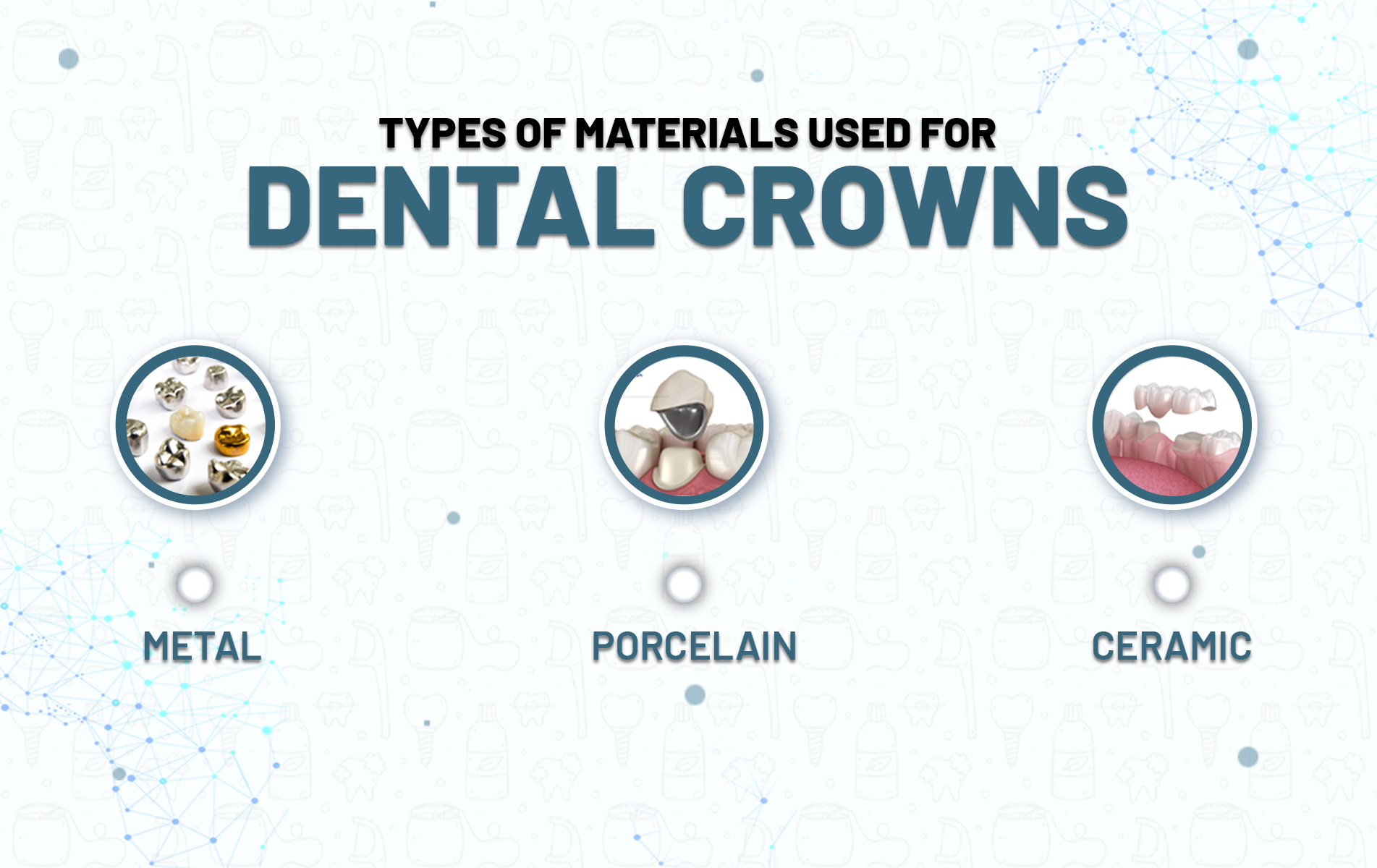
There are three types of materials that are used depending on a patient’s teeth condition, size, and color.
-
Ceramic
It is the best and more suitable options for people who have less space in their mouth for a crown to fit. These crowns are made from a thin material that makes them lighter than other crowns.
-
Porcelain
These crowns mimic the appearance of the tooth enamel more than any other materials used. They are the best crown option for people with metal allergies.
They are more durable than ceramic crowns, and they tend to last longer than others.
-
Metal
Metal crowns can be made up of gold alloy, chromium, and nickel. While using metal crowns, less tooth structure is required to be removed, and they are subject to wear less than any other crowns.
These crowns are relatively more durable, cost effective, and are less likely to chip or break than other crowns.
Differences Between Crowns And Other Dental Restorations
-
Fillings
Fillings are less costly than crowns and are commonly used to treat damaged or decayed teeth. Whereas, a crown is used in more severe conditions.
A filling only treats the affected area, and leaves the other parts of the natural tooth as it is. Fillings can only treat small cracks and it cannot treat large cracks or a severely damaged tooth.
-
Veneers
Veneers only cover the front surface of your tooth that is mainly used for enhancing the appearance of the tooth making it look more aligned, brighter, and shinier.
Whereas, a crowns on teeth covers all the parts of the teeth restoring its function, shape, size, and also to enhance overall dental appearance.
Why Would You Need A Crown?
-
Restoring A Damaged Or Decayed Tooth
A dental crown is a tooth-shaped cap mainly used in restoring a damaged or decayed tooth by removing the damaged or decayed part, shaping the teeth and covering it with a crown that looks exactly like your natural teeth.
-
Protecting A Weak Tooth From Breaking
Dentists also recommend you to get a dental crown to save a weakened, cracked or a severely worn down tooth from breaking by covering it with a teeth-shaped cap.
It prevents a damaged tooth from breaking by covering the tooth and reinforcing its weakened or damaged structure.
-
After Root Canal Therapy
After the Root canal procedure, patients are left with painless and hollowed out teeth because the tooth no longer contains the pulp inside it.
The treated teeth in the back of the mouth, such as (molars and premolars) required extra support because they bear the most bite forces.
Then, a crown is used to support the teeth and ensure that no further damage occurs. You can have teeth crowns before and after root canal treatment.
-
Cosmetic Improvements (tooth shape, size, or color)
Dental crowns are also purely used for cosmetic reasons. Patients who are not happy with the shape, size, and color of your teeth are mostly recommended to get dental crowns.
A dental professional will place a crown to improve the irregularity, size, and color of your teeth for a more aesthetic and perfect smile.
Process Of Getting A Dental Crown
Initially, a dentist will prepare your tooth by removing the upper surface of the teeth to shape it so that it can fit properly under the crown, using a local anesthetic to prevent feeling of pain.
Next, they will take an impression of your tooth using an impression pressed into the mold or by a digital scanner.
The impression will be sent to lab, where a technician will make a crown to fit your tooth, and cover the affected area with a temporary teeth caps.
When the crown will be ready, you will return for your second appointment in which your dentist will fit the crown using a dental cement or an adhesive.
Types Of Dental Crowns
There are several types of crowns for teeth that are available, and the right one for you depends on your personal preference and according to your dental needs.
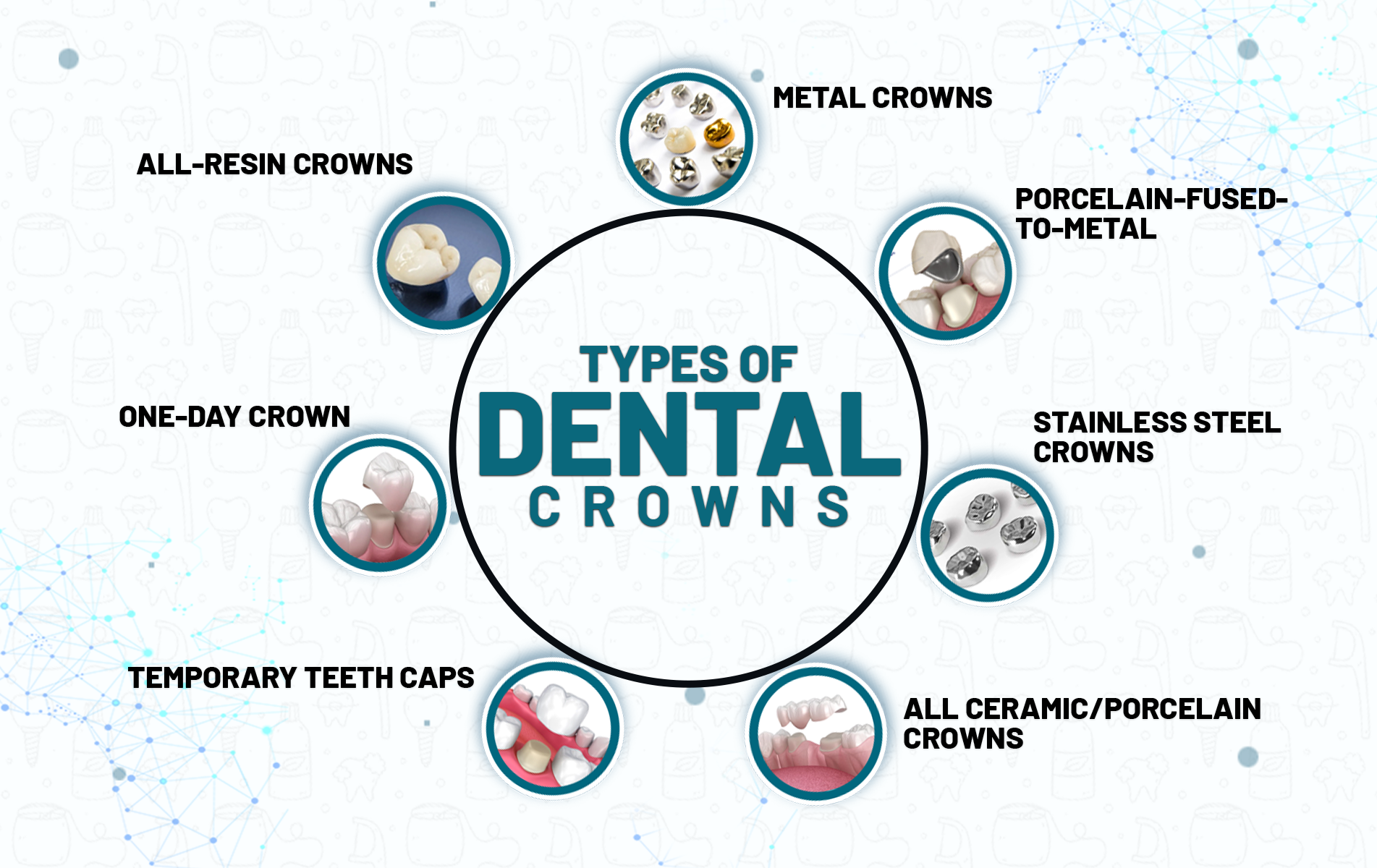
- Metal crowns
- Porcelain-fused-to-metal (PFM) crowns
- All Ceramic/Porcelain crowns
- All-resin crowns
- One-day crown
- Temporary teeth caps
- Stainless steel crowns
Alternatives To Dental Crowns
There are many alternative treatments of dental crowns that are less costly than crowns and provide the same dental solutions as dental crowns.
These alternative methods are cheaper, but help in treating weak, damaged or decayed teeth restoring their functionality.
-
Onlays
Instead of placing a dental crown, your dentist may preferably use Onlays that are a type of crown that offers protection to teeth but to a smaller degree. It doesn’t require more tooth structure removal than other crowns lowering the risk of complications.
-
Veneers
A dentist may decide to place a veneer depending on the condition of the tooth. Veneers are thin shells that covers the surface of your front tooth typically used for aesthetic reasons.
-
Fillings
A dentist might use fillings, if the tooth has a cavity that can be easily removed and treated with fillings. It is also used to build up a tooth that has been severely damaged by a fracture or decay before covering it with dental crowns.
Pros And Cons of Dental Crowns
Pros
Some of the main advantages of getting crowns are –
-
Restoration Of Function And Strength
Damaged or cracked teeth caused due to cavities can be treated, replaced, and restored to its original condition by getting dental crowns. A crown not only treats damaged teeth, but it also helps in supporting the teeth improving its functionality and strength.
-
Enhanced Appearance
Most people with misaligned or irregular teeth use crowns to enhance their appearance, and to get a more aligned placement of teeth for a perfect, beautiful, and radiant smile.
-
Improved Bites
Crowns also help in improving bites, and speak in patients with damaged, decayed, or misaligned teeth. It bridges the gaps between the teeths due to a lost or missing tooth for a wide and perfect bite.
Cons
The disadvantages of getting dental crowns are –
-
Tooth Enamel Reduction
Getting dental crowns requires reduction of tooth structure or enamel reduction so that the crown can cover the teeth that looks like a natural teeth.
-
Risk Of Nerve Damage
Reduction in tooth enamel causes a higher risk of nerve damage on the inner part of the tooth, causing sensitivity or pain that can be temporary or may require proper treatment to heal.
-
Costly
Dental crowns are much more costly than other alternative treatments such as Fillings, and Veneers. Crowns can range from $800 to $1500 or more depending on the material used to make a crown.
The cost may also rise if the dentist has to perform more extensive prep work before putting crowns.
FAQ
Will I feel pain after getting a crown?
Yes, you may experience some level of pain and discomfort after getting a dental crown, but the pain lasts for a few days.
How do I know if my crown needs replacement?
You must replace your dental crowns if you experience persistent pain, swelling, and sensitivity around your teeth or if your crown is loose, cracked, or chipped.
Can You Whiten Crown Teeth
No, you cannot whiten dental crowns because they are made up of materials that do not respond to whitening treatments.
How Long Do Crowns Last On Front Teeth
Crowns typically last between 5 – 15 years, but with good oral hygiene and dental care some last longer than that.
Conclusion
Metal crowns may be a good option for you if you’re looking for a durable, and natural-looking crown, and don’t want to wait for weeks to get it.
Talk to a dentist about your preferences and discuss whether this method is good for your oral health and if it fits your budget.

